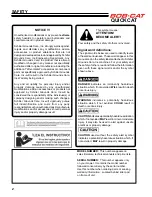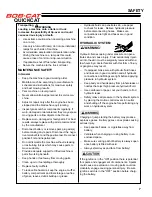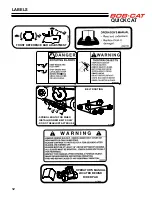
6
QUICKCAT
SAFETY
CHILDREN
– Tragic accidents can occur if the operator is not
alert to the presence of children Children are
often attracted to themachine and the mowing
activity. Never assume that children will remain
where you last saw them.
– Keep children out of the operating area and un-
der the watchful care of a responsible adult other
than the operator.
– Do not carry children, even with the blade(s)
shut off. Children could fall off and be seriously
injured or interfere with safe machine operation.
Children who have been given rides in the past
could suddenly appear in the mowing area for
another ride and be run over or backed over by
the machine.
MOWING SLOPES
Operating on wet grass or steep slopes can cause
sliding and loss of control. Wheels dropping
over edges, ditches, steep banks, or into water
can cause roll overs, which may result in serious
injury, death or drowning. Slopes are a major
factor related to accidents. Operation on slopes
requires extra caution.
– DO NOT mow slopes when grass is wet.
– DO NOT mow near drop-offs or water.
– Reduce speed and use extreme caution on
slopes.
– Do not operate machine under any condition
where traction, steering, or stability is in question.
Tires could slide even if the wheels are stopped.
– Avoid sudden turns or rapid speed changes.
– Do not mow on slopes if uneasy or uncertain.
Ultimate responsibility for safe operation on
slopes rests with the operator.
– Do not mow excessively steep slopes.
– With ride-on machines, including articulated
steering machines, mow up and down slopes, not
across, except for zero turn machines. Zero turn
machines should mow across slopes.
– With walk-behind machines, mow across slopes,
not up and down.
– With zero turn machines, mow across slopes, not
up and down. If the machine will not stay on the
slope, it is too steep.
WARNING
– Mid-mount zero turn (belly mounted deck)
machines have much greater traction pointed up
slope then down slope. Be aware that traction
may be lost going down a slope. Do not operate
a mid-mount zero turn on slopes it cannot back
up.
– Avoid starting or stopping on a slope. If tires
lose traction, disengage the blades and proceed
slowly straight down the slope.
– With a zero turn machine, if tires lose traction
going down a slope, steering control may be
regained by speeding up.
– Keep all movement on the slopes slow and
gradual. Do not make sudden changes in speed
or direction.
– Do not turn on slopes unless necessary, and then
turn slowly and downhill when possible.
– Stay away from slopes if the ground is loose or if
caught in the rain during mowing.
– Use extra care with grass catchers or other
attachments. These can change the stability of
the machine.
– Remove obstacles such as rocks, tree limbs, etc.
from the grass cutting area.
– Avoid driving over obstacles such as ruts, holes,
rocks and roots whenever possible. Be alert to
dips and rises. Uneven terrain can overturn a
mower or cause it to slide. Tall grasses can hide
obstacles.
– Do not mow drop-offs, ditches or embankments.
The machine could suddenly turn over if a wheel
runs over the edge or an edge caves in.
– Follow the manufacturer's recommendations
for wheel weights or counterweights to improve
stability.
– Be aware that operating on wet grass, across
steep slopes or downhill may cause the mower to
lose traction. Loss of traction to the drive wheels
may result in sliding and loss of braking and
steering. Use a walk behind mower and /or hand
trimmer near drop-offs, ditches, steep banks or
water.
TOWING
– Follow the manufacturer's recommendation for
weight limits for towed equipment and towing on
slopes.









































